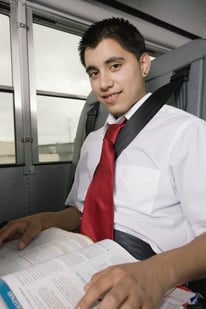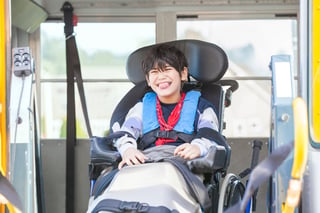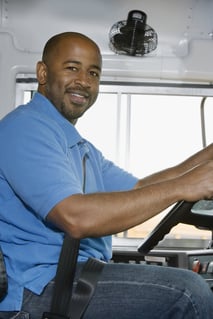 Here's some trivia for you – did you know (as of 2017), only six states require seat belts on school buses? This may seem unsafe, but let's look at the facts. According to the American School Bus Council, children are about 70 times more likely to get to school safely if they take the school bus, instead of traveling by car.
Here's some trivia for you – did you know (as of 2017), only six states require seat belts on school buses? This may seem unsafe, but let's look at the facts. According to the American School Bus Council, children are about 70 times more likely to get to school safely if they take the school bus, instead of traveling by car.
However, many organizations endorse the use of seat belts in buses, including The National Safety Council and The American Academy of Pediatrics. Although the National Highway Safety Traffic Administration (NHTSA) agrees that school buses are safe, they also believe that three-point restraint systems can make school buses even safer.
Child safety restraint systems are national mandates on buses when the bus weighs less than 10,000 pounds. These buses require a shoulder/lap belt. However, such buses comprise only about 20% of the nation's school bus fleet. The large school buses should have a Child Safety Restraint System (CSRS) if the state or district requires them – but it's not federally mandated.
What About School Bus Safety for Younger Children?
Child safety restraint systems are mandatory when transporting:
- Students under five years old
- Students weighing under 50 pounds
- Head Start students
- Children requiring it as part of an IEP (individualized education plan)
Safety restraint systems for children in these categories must meet certain requirements - a simple lap belt is inadequate. Below, we’ll discuss several different types of CSRS's for different needs.
Rear-Facing Only
 A rear-facing child safety restraint system is required for transporting children two years old and younger, and is typically installed with a lap belt or LATCH (Lower Anchors and Tethers for Children) system. The seat should be installed at a 45-degree angle (following car seat instructions), and have harness straps and a chest clip.
A rear-facing child safety restraint system is required for transporting children two years old and younger, and is typically installed with a lap belt or LATCH (Lower Anchors and Tethers for Children) system. The seat should be installed at a 45-degree angle (following car seat instructions), and have harness straps and a chest clip.
The child should occupy a rear-facing seat until they reach the minimum recommended age, weight, and height limit of a forward-facing seat. If you’re wondering if your child is truly safe, the NHTSA has some helpful best practices for infant and young child seating on buses.
Convertible or Forward-Facing
The CSRS for children over the age of two requires the child faces forward and sits upright. Just like the rear-facing seat, forward-facing seats also have harness straps and a chest clip. The child should use this seat until they reach the seat's recommended weight and height limits, or until the child’s ears are above the top of the seat.
Integrated Seats
These are seats with built-in restraint systems which have both harness straps and chest clips. The child should use this seat until they outgrow the height and weight maximum, or until their shoulders are above the top harness slot of the seat.
Add-On Seats
An add-on seat may be fitted to an existing school bus seat. It has harness straps and a chest clip. The child can use this seat until they outgrow the height and weight maximum, or until their shoulders are above the top harness slot. It's important to note that an add-on seat can only be used if the seat behind it is either empty or contains a child in another CSRS.
Lap Belts
Lap belts are appropriate for older children who don't fit into the above-listed CSRS categories. However, it is important to remember that they do not provide protection for the upper body (spine, neck, and head).
 Final Important Safety Tips
Final Important Safety Tips
Please keep these points in mind when using child safety restraint systems on school buses:
- Always follow the instructions in the system's manual, including the minimum and maximum height/weight requirements
- Never use both a belt and a LATCH system to install a CSRS; use one or the other
- A booster seat is never appropriate for use on a school bus
- Never install a CSRS at an emergency exit
- Never make custom changes to a CSRS to make it fit
- If the CSRS has been involved in an incident, check with the manufacturer for guidelines on replacement
- The NHTSA recommends replacing child safety restraint systems every five years




